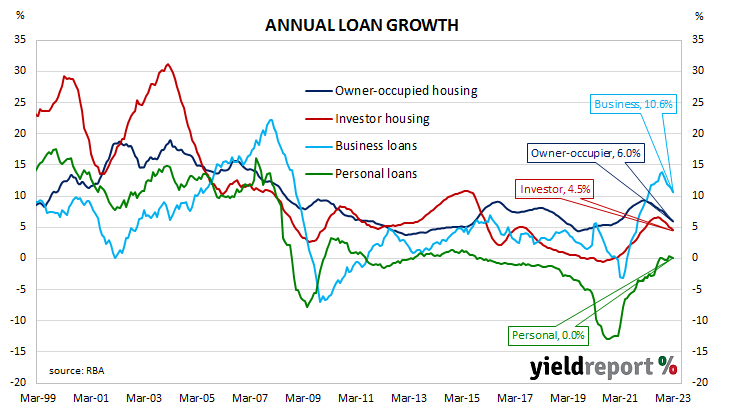28 April 2023
Summary: Private sector credit up 0.3% in March, in line with expectations; annual growth rate slows from 7.2% to 6.8%; credit growth stuck in “slow lane”; bond yields down, rate-cut expectations soften; business lending segment account for 45% of net growth.
The pace of lending growth in the non-bank private sector by financial institutions in Australia followed a steady-but-gradual downtrend from late-2015 through to early 2020 before hitting what appears to be a nadir in March 2021. That downtrend ended later in the same year and annual growth rates shot up through 2022, peaking in October.
According to the latest RBA figures, private sector credit increased by 0.3% in March. The result was in line with expectations but less than February’s 0.4% rise. On an annual basis, the growth rate slowed from 7.2% to 6.8%.
“Over the past six months to March 2023, credit growth has been stuck in the slow lane, with the monthly pace holding relatively steady,” said Westpac senior economist Andrew Hanlan.
Commonwealth Government bond yields moved lower on the day, ignoring noticeable upward movements of US Treasury yields overnight. By the close of business, the 3-year ACGB yield had slipped 1bp to 2.98%, the 10-year yield had lost 3bps to 3.34% while the 20-year yield finished 5bps lower at 3.78%.
In the cash futures market, expectations regarding rate cuts in 2024 softened. At the end of the day, contracts implied the cash rate would move from the current rate of 3.57% to average 3.59% in May and then increase to an average of 3.62% through June. November contracts implied a 3.605% average cash rate while May 2024 contracts implied 3.38%, 19bps below the current cash rate.
Business lending accounted for about 45% of the net growth over the month, while lending in the owner-occupier segment accounted for about 25%. Investor lending accounted for the balance.
The traditional driver of overall loan growth, the owner-occupier segment, grew by 0.3% over the month, down from the 0.4% growth rate of the previous four months. The sector’s 12-month growth rate slowed again, this time from 6.3% to 6.0%.
Total lending in the non-financial business sector increased by 0.4%, down from the 0.6% increase recorded in the previous month. Growth on an annual basis slowed from 11.3% to 10.6%.
Monthly growth in the investor-lending segment slowed to a near-halt in early 2018 and essentially stayed that way until mid-2021. In March, net lending grew by 0.3%, up from 0.2% in February, taking the 12-month growth rate from 4.8% to 4.5%.
Total personal loans fell by 0.3%, down from February’s revised figure of -0.1%, taking the annual growth rate from 0.3% to 0.0%. This category of debt includes fixed-term loans for large personal expenditures, credit cards and other revolving credit facilities.
28 April 2023
Summary: Private sector credit up 0.6% in April, greater than expected; annual growth rate slows from 6.8% to 6.6%; Westpac: business loan growth a one-off, broader outlook remains subdued; bond yields down, rate-cut expectations soften slightly; business lending segment accounts for 60% of net growth.
The pace of lending growth in the non-bank private sector by financial institutions in Australia followed a steady-but-gradual downtrend from late-2015 through to early 2020 before hitting what appears to be a nadir in March 2021. That downtrend ended later in the same year and annual growth rates shot up through 2022, peaking in October.
According to the latest RBA figures, private sector credit increased by 0.6% in April. The result was greater than the 0.3% increase which had been generally expected as well as March’s 0.2% rise after it was revised down from 0.3%. On an annual basis, the growth rate slowed from 6.8% to 6.6%.
“Given the high likelihood of April’s monthly outcome for business being a one-off and the approaching weakness in activity, the broader outlook for credit growth remains subdued,” said Westpac economist Ryan Wells.
Commonwealth Government bond yields moved lower on the day, ignoring noticeable upward movements of US Treasury yields overnight. By the close of business, the 3-year ACGB yield had slipped 1bp to 2.98%, the 10-year yield had lost 3bps to 3.34% while the 20-year yield finished 5bps lower at 3.78%.
In the cash futures market, expectations regarding rate cuts in 2024 softened. At the end of the day, contracts implied the cash rate would move from the current rate of 3.57% to average 3.59% in May and then increase to an average of 3.62% through June. November contracts implied a 3.605% average cash rate while May 2024 contracts implied 3.38%, 19bps below the current cash rate.
Business lending accounted for about 45% of the net growth over the month, while lending in the owner-occupier segment accounted for about 25%. Investor lending accounted for the balance.
The traditional driver of overall loan growth, the owner-occupier segment, grew by 0.3% over the month, down from the 0.4% growth rate of the previous four months. The sector’s 12-month growth rate slowed again, this time from 6.3% to 6.0%.
Total lending in the non-financial business sector increased by 0.4%, down from the 0.6% increase recorded in the previous month. Growth on an annual basis slowed from 11.3% to 10.6%.
Monthly growth in the investor-lending segment slowed to a near-halt in early 2018 and essentially stayed that way until mid-2021. In March, net lending grew by 0.3%, up from 0.2% in February, taking the 12-month growth rate from 4.8% to 4.5%.
Total personal loans fell by 0.3%, down from February’s revised figure of -0.1%, taking the annual growth rate from 0.3% to 0.0%. This category of debt includes fixed-term loans for large personal expenditures, credit cards and other revolving credit facilities.



